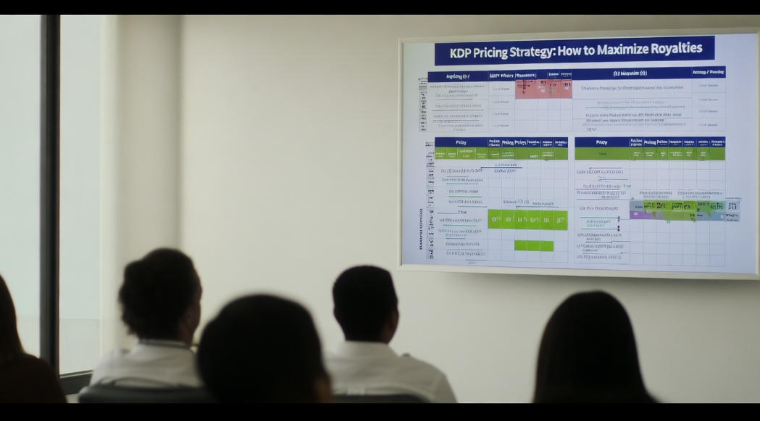When it comes to self-publishing on Amazon Kindle Direct Publishing (KDP), most writers spend endless hours perfecting their manuscript, designing covers, and polishing formatting. But here’s the surprising truth: your pricing strategy can make or break your royalties.
Yes, the price you set isn’t just a number—it’s the invisible hand that guides your book’s sales, visibility, and how much you actually earn. And sadly, a lot of authors either underprice themselves (and leave money on the table) or overprice (and lose readers who never even give their book a chance).
So, let’s break it down in plain language—no jargon, no boring theories. Just simple strategies you can actually use today.
Why pricing is more than just numbers
Think of pricing like setting the mood for your book. A $0.99 book says: “I’m affordable, just give me a try.” A $9.99 book says: “I’m serious, I have value.”
Both approaches can work, but they attract completely different readers. The trick is finding the sweet spot between attracting buyers and maximizing royalties.
Amazon’s royalty structure is pretty straightforward:
| Price Range | Royalty Rate | Notes |
|---|---|---|
| $0.99 – $2.98 | 35% | Lower royalty but may attract impulse buyers |
| $2.99 – $9.99 | 70% | The “golden zone” for most indie authors |
| $10.00+ | 35% | Harder to sell unless it’s highly specialized |
Notice the magic number? The $2.99–$9.99 range is where most authors thrive. Not only do you get the 70% royalty, but readers also see it as affordable compared to traditional publishing.
The psychology of readers and price tags
Here’s something many writers forget: buyers don’t just purchase with logic—they buy with emotion.
-
At $0.99, readers think: “Why not? It’s just a dollar.”
-
At $2.99, they feel: “This seems like a fair price for a whole book.”
-
At $4.99 to $6.99, they think: “Okay, this must have real value, maybe like a traditionally published ebook.”
-
At $9.99, readers often compare it with a physical book and might hesitate unless the book has strong reviews.
So, your price isn’t just about money—it’s a message about quality.
Finding your sweet spot
Now comes the tricky part. How do you decide your exact price? Here are some practical strategies:
✅ Check your genre’s average price – Romance ebooks often sell well at $2.99–$4.99, while non-fiction guides or self-help can easily command $6.99–$9.99.
✅ Factor in length – A short novella at $7.99 might turn readers away, but a 400-page comprehensive guide could justify it.
✅ Consider audience expectations – Budget-conscious readers (young adult, romance, light fiction) lean toward lower prices. Niche professional readers (business, technical, health) often pay higher without hesitation.
✅ Experiment – Don’t be afraid to adjust pricing every few months to see how it impacts sales.
The golden rule of royalties: 70% is not always better
It’s tempting to think: “Why would I ever choose 35% when I can get 70%?” But hold on. There are situations where a lower royalty might still be better overall.
For example:
-
If you price your book at $0.99 and sell 1,000 copies, you might earn less per book but gain a ton of new readers, reviews, and visibility.
-
If you price your book at $5.99 with 70% royalty but only sell 50 copies, your income might actually be lower.
Sometimes volume beats royalty rate. Sometimes the opposite is true. That’s why testing is key.
Bundling and series strategy
If you’re writing a series, here’s a clever trick:
-
Price the first book low ($0.99 or even free during promos) to attract new readers.
-
Price the later books higher ($3.99–$6.99) because by then, readers are invested and more willing to pay.
This creates a funnel effect where Book 1 is your hook, and Books 2, 3, and beyond are your steady income.

KDP Select and Kindle Unlimited royalties
Another thing authors overlook is Kindle Unlimited (KU). Instead of getting paid per sale, you get paid per page read.
This means:
-
Longer books can earn more even if priced higher.
-
Keeping readers engaged matters more than the sticker price.
-
KU readers usually don’t even see your listed price—they’re borrowing under their subscription.
So, if you’re enrolled in KDP Select, your pricing strategy matters a bit less in KU, but it still matters for buyers outside the subscription.
Global pricing matters too
Amazon lets you set prices in different marketplaces (US, UK, India, etc.). Don’t ignore this! 🌍
A price that feels fair in the US may be too expensive in India. Many smart authors set localized prices to match the buying power of each country. For example:
-
$2.99 in the US might become ₹149 in India.
-
£2.49 in the UK feels more natural than directly converting $2.99.
This small adjustment can boost your international sales.
Practical mistakes to avoid
🚫 Don’t price too high without credibility. Unknown authors asking $14.99 often see no sales.
🚫 Don’t undervalue your work. Constantly selling at $0.99 can make readers think your book has no quality.
🚫 Don’t forget promotions. Temporary discounts, Kindle Countdown Deals, and free promos can spike sales and reviews.
Quick example: Earnings comparison
Let’s imagine you sell a 200-page ebook.
| Price | Royalty % | Earnings per Sale | Copies Sold (estimate) | Total Earnings |
|---|---|---|---|---|
| $0.99 | 35% | $0.35 | 1000 | $350 |
| $2.99 | 70% | $2.09 | 300 | $627 |
| $5.99 | 70% | $4.19 | 120 | $502 |
| $9.99 | 70% | $6.99 | 60 | $419 |
See how $2.99 often becomes the sweet spot? Enough affordability for readers, and enough royalties for you.
Simple steps to maximize royalties right now
-
Start with $2.99–$4.99 for most genres.
-
Increase price gradually if reviews and sales are strong.
-
Use promotions like $0.99 deals for visibility.
-
Optimize international pricing for each marketplace.
-
Track sales monthly and adjust as needed.
Remember: pricing isn’t permanent. It’s a flexible tool you can tweak whenever you need.
FAQs
Q: Should I always price at $2.99?
Not always. It’s a good starting point, but your genre, length, and competition might justify higher or lower prices.
Q: Is free pricing worth it?
Yes, but only temporarily. Free promotions can help you get reviews and visibility, but don’t stay free forever.
Q: What about paperbacks?
Paperbacks have higher costs, so $9.99–$14.99 is common. But for ebooks, staying in the sweet zone matters more.
Q: Do royalties change outside the US?
Slightly. Taxes, exchange rates, and country-specific royalty rules can apply. Always check your KDP dashboard.
Final thoughts
At the end of the day, pricing your KDP book is a balancing act. You’re not just slapping a number on your cover—you’re setting the stage for how readers see your work.
Think of it this way: your price should reflect both the value you offer and the readers you want to attract. Start small, experiment, analyze results, and adjust. With the right strategy, you won’t just earn more royalties—you’ll also grow a loyal reader base who believes your work is worth every penny.
And that’s the real win. 🚀




